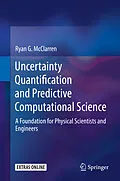This textbook teaches the essential background and skills for understanding and quantifying uncertainties in a computational simulation, and for predicting the behavior of a system under those uncertainties. It addresses a critical knowledge gap in the widespread adoption of simulation in high-consequence decision-making throughout the engineering and physical sciences.Constructing sophisticated techniques for prediction from basic building blocks, the book first reviews the fundamentals that underpin later topics of the book including probability, sampling, and Bayesian statistics. Part II focuses on applying local sensitivity analysis to apportion uncertainty in the model outputs to sources of uncertainty in its inputs. Part III demonstrates techniques for quantifying the impact of parametric uncertainties on a problem, specifically how input uncertainties affect outputs. The final section covers techniques for applying uncertainty quantification to make predictions under uncertainty, including treatment of epistemic uncertainties. It presents the theory and practice of predicting the behavior of a system based on the aggregation of data from simulation, theory, and experiment.
- Organizes interdisciplinary topics of uncertainty quantification into a single teaching text
- Reviews the fundamentals of probability and statistics
- Guides the transition from merely performing calculations to making confident predictions
- Builds readers' confidence in the validity of their simulations
- Illustrates concepts with real-world examples and models from the physical sciences and engineering
- Includes R and python code, enabling readers to perform the analysis
Autorentext
Ryan McClarren has been teaching uncertainty quantification and predictive computational science to students from various engineering and physical science departments at since 2009. He is currently Associate Professor of Aerospace and Mechanical Engineering at the University of Notre Dame. Prior to joining Notre Dame in 2017, he was Assistant Professor of Nuclear Engineering at Texas A&M University, an institution well-known in the nuclear engineering community for its computational research and education. He has authored numerous publications in refereed journals, is the author of a book that teaches python and numerical methods to undergraduates, Computational Nuclear Engineering and Radiological Science Using Python, and was the editor of a special issue of the journal Transport Theory and Statistical Physics. A well-known member of the computational nuclear engineering community, he has won research awards from NSF, DOE, and three national labs. While an undergraduate at the University of Michigan he won three awards for creative writing. Before joining the faculty of Texas A&M, Dr. McClarren was a research scientist at Los Alamos National Laboratory in the Computational Physics and Methods group.
Inhalt
